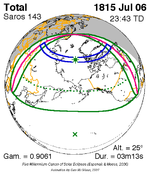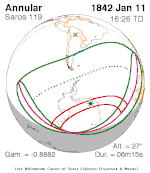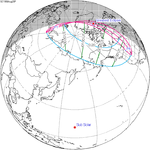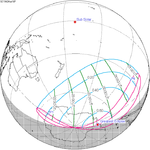Solar eclipse of August 19, 1887
| Solar eclipse of August 19, 1887 | |
|---|---|
| Type of eclipse | |
| Nature | Total |
| Gamma | 0.6312 |
| Magnitude | 1.0518 |
| Maximum eclipse | |
| Duration | 230 s (3 min 50 s) |
| Coordinates | 50°36′N 111°54′E / 50.6°N 111.9°E |
| Max. width of band | 221 km (137 mi) |
| Times (UTC) | |
| Greatest eclipse | 5:32:05 |
| References | |
| Saros | 143 (16 of 72) |
| Catalog # (SE5000) | 9251 |
A total solar eclipse occurred at the Moon's ascending node of orbit on Friday, August 19, 1887, with a magnitude of 1.0518. A solar eclipse occurs when the Moon passes between Earth and the Sun, thereby totally or partly obscuring the image of the Sun for a viewer on Earth. A total solar eclipse occurs when the Moon's apparent diameter is larger than the Sun's, blocking all direct sunlight, turning day into darkness. Totality occurs in a narrow path across Earth's surface, with the partial solar eclipse visible over a surrounding region thousands of kilometres wide. Occurring about 1.8 days before perigee (on August 21, 1887, at 0:10 UTC), the Moon's apparent diameter was larger.[1]
The path of totality was visible from parts of modern-day Germany, Poland, Belarus, Lithuania, southeastern Latvia, Russia, Mongolia, China, North Korea, and Japan. A partial solar eclipse was also visible for parts of Europe, Northeast Africa, Asia, northern Greenland, and Alaska.
Observations
[edit]The Russian chemist Dmitri Mendeleev ascended in a balloon near Moscow to observe this eclipse. The weather in Tver Governorate was cloudy and it was rain at morning, so Mendeleev forced to fly alone. He made some notes at 6:55, 20 minutes after the start, and made some observations of the solar corona. For this flight, the scientist was awarded the medal of the Academy of Aerostatic Meteorology.[2]

|
 Partiality at sunrise from Berlin, Germany |
 Ilya Repin, “The Solar Eclipse of 1887” (“Dmitri Ivanovich Mendeleev on the aerostat”), 1887. |
Russian writer Anton Chekhov published the short story "From the Diary of a Hot-Tempered Man" six weeks before the eclipse passed through Russia. The story includes a major section about the frustrations of a man who is trying to make a great variety of observations during the short interval of totality. In the story the eclipse date is given as 7 August 1887, as per the Julian Calendar then in use in Russia.
Eclipse details
[edit]Shown below are two tables displaying details about this particular solar eclipse. The first table outlines times at which the moon's penumbra or umbra attains the specific parameter, and the second table describes various other parameters pertaining to this eclipse.[3]
| Event | Time (UTC) |
|---|---|
| First Penumbral External Contact | 1887 August 19 at 03:05:23.2 UTC |
| First Umbral External Contact | 1887 August 19 at 04:09:44.3 UTC |
| First Central Line | 1887 August 19 at 04:11:03.8 UTC |
| First Umbral Internal Contact | 1887 August 19 at 04:12:23.8 UTC |
| Equatorial Conjunction | 1887 August 19 at 05:15:23.5 UTC |
| Greatest Duration | 1887 August 19 at 05:31:45.2 UTC |
| Greatest Eclipse | 1887 August 19 at 05:32:05.2 UTC |
| Ecliptic Conjunction | 1887 August 19 at 05:38:34.1 UTC |
| Last Umbral Internal Contact | 1887 August 19 at 06:51:56.7 UTC |
| Last Central Line | 1887 August 19 at 06:53:18.3 UTC |
| Last Umbral External Contact | 1887 August 19 at 06:54:39.5 UTC |
| Last Penumbral External Contact | 1887 August 19 at 07:58:51.2 UTC |
| Parameter | Value |
|---|---|
| Eclipse Magnitude | 1.05176 |
| Eclipse Obscuration | 1.10619 |
| Gamma | 0.63124 |
| Sun Right Ascension | 09h52m33.6s |
| Sun Declination | +12°53'52.0" |
| Sun Semi-Diameter | 15'48.5" |
| Sun Equatorial Horizontal Parallax | 08.7" |
| Moon Right Ascension | 09h53m11.8s |
| Moon Declination | +13°30'38.5" |
| Moon Semi-Diameter | 16'24.8" |
| Moon Equatorial Horizontal Parallax | 1°00'14.3" |
| ΔT | -6.0 s |
Eclipse season
[edit]This eclipse is part of an eclipse season, a period, roughly every six months, when eclipses occur. Only two (or occasionally three) eclipse seasons occur each year, and each season lasts about 35 days and repeats just short of six months (173 days) later; thus two full eclipse seasons always occur each year. Either two or three eclipses happen each eclipse season. In the sequence below, each eclipse is separated by a fortnight.
| August 3 Descending node (full moon) |
August 19 Ascending node (new moon) |
|---|---|

| |
| Partial lunar eclipse Lunar Saros 117 |
Total solar eclipse Solar Saros 143 |
Related eclipses
[edit]Eclipses in 1887
[edit]- A partial lunar eclipse on February 8.
- An annular solar eclipse on February 22.
- A partial lunar eclipse on August 3.
- A total solar eclipse on August 19.
Metonic
[edit]- Preceded by: Solar eclipse of October 30, 1883
- Followed by: Solar eclipse of June 6, 1891
Tzolkinex
[edit]- Preceded by: Solar eclipse of July 7, 1880
- Followed by: Solar eclipse of September 29, 1894
Half-Saros
[edit]- Preceded by: Lunar eclipse of August 13, 1878
- Followed by: Lunar eclipse of August 23, 1896
Tritos
[edit]- Preceded by: Solar eclipse of September 17, 1876
- Followed by: Solar eclipse of July 18, 1898
Solar Saros 143
[edit]- Preceded by: Solar eclipse of August 7, 1869
- Followed by: Solar eclipse of August 30, 1905
Inex
[edit]- Preceded by: Solar eclipse of September 7, 1858
- Followed by: Solar eclipse of July 30, 1916
Triad
[edit]- Preceded by: Solar eclipse of October 18, 1800
- Followed by: Solar eclipse of June 20, 1974
Solar eclipses of 1884–1888
[edit]This eclipse is a member of a semester series. An eclipse in a semester series of solar eclipses repeats approximately every 177 days and 4 hours (a semester) at alternating nodes of the Moon's orbit.[4]
The partial solar eclipses on April 25, 1884 and October 19, 1884 occur in the previous lunar year eclipse set, and the partial solar eclipse on July 9, 1888 occurs in the next lunar year eclipse set.
| Solar eclipse series sets from 1884 to 1888 | ||||||
|---|---|---|---|---|---|---|
| Descending node | Ascending node | |||||
| Saros | Map | Gamma | Saros | Map | Gamma | |
| 108 | March 27, 1884 Partial |
1.4602 | 113 | |||
| 118 | March 16, 1885 Annular |
0.8030 | 123 | September 8, 1885 Total |
−0.8489 | |
| 128 | March 5, 1886 Annular |
0.0970 | 133 | August 29, 1886 Total |
−0.1059 | |
| 138 | February 22, 1887 Annular |
−0.6040 | 143 | August 19, 1887 Total |
0.6312 | |
| 148 | February 11, 1888 Partial |
−1.2684 | 153 | August 7, 1888 Partial |
−1.2797 | |
Saros 143
[edit]This eclipse is a part of Saros series 143, repeating every 18 years, 11 days, and containing 72 events. The series started with a partial solar eclipse on March 7, 1617. It contains total eclipses from June 24, 1797 through October 24, 1995; hybrid eclipses from November 3, 2013 through December 6, 2067; and annular eclipses from December 16, 2085 through September 16, 2536. The series ends at member 72 as a partial eclipse on April 23, 2897. Its eclipses are tabulated in three columns; every third eclipse in the same column is one exeligmos apart, so they all cast shadows over approximately the same parts of the Earth.
The longest duration of totality was produced by member 16 at 3 minutes, 50 seconds on August 19, 1887, and the longest duration of annularity will be produced by member 51 at 4 minutes, 54 seconds on September 6, 2518. All eclipses in this series occur at the Moon’s ascending node of orbit.[5]
| Series members 12–33 occur between 1801 and 2200: | ||
|---|---|---|
| 12 | 13 | 14 |
 July 6, 1815 |
 July 17, 1833 |
 July 28, 1851 |
| 15 | 16 | 17 |
 August 7, 1869 |
 August 19, 1887 |
 August 30, 1905 |
| 18 | 19 | 20 |
 September 10, 1923 |
 September 21, 1941 |
 October 2, 1959 |
| 21 | 22 | 23 |
 October 12, 1977 |
 October 24, 1995 |
 November 3, 2013 |
| 24 | 25 | 26 |
 November 14, 2031 |
 November 25, 2049 |
 December 6, 2067 |
| 27 | 28 | 29 |
 December 16, 2085 |
 December 29, 2103 |
 January 8, 2122 |
| 30 | 31 | 32 |
 January 20, 2140 |
 January 30, 2158 |
 February 10, 2176 |
| 33 | ||
 February 21, 2194 | ||
Metonic series
[edit]The metonic series repeats eclipses every 19 years (6939.69 days), lasting about 5 cycles. Eclipses occur in nearly the same calendar date. In addition, the octon subseries repeats 1/5 of that or every 3.8 years (1387.94 days). All eclipses in this table occur at the Moon's ascending node.
| 24 eclipse events between March 25, 1819 and August 20, 1906 | ||||
|---|---|---|---|---|
| March 25–26 | January 11–12 | October 30–31 | August 18–20 | June 6–7 |
| 107 | 109 | 111 | 113 | 115 |
 March 25, 1819 |
 January 12, 1823 |
 October 31, 1826 |
 August 18, 1830 |
 June 7, 1834 |
| 117 | 119 | 121 | 123 | 125 |
 March 25, 1838 |
 January 11, 1842 |
 October 30, 1845 |
 August 18, 1849 |
 June 6, 1853 |
| 127 | 129 | 131 | 133 | 135 |
 March 25, 1857 |
 January 11, 1861 |
 October 30, 1864 |
 August 18, 1868 |
 June 6, 1872 |
| 137 | 139 | 141 | 143 | 145 |
 March 25, 1876 |
 January 11, 1880 |
 October 30, 1883 |
 August 19, 1887 |
 June 6, 1891 |
| 147 | 149 | 151 | 153 | |
 March 26, 1895 |
 January 11, 1899 |
 October 31, 1902 |
 August 20, 1906 | |
Tritos series
[edit]This eclipse is a part of a tritos cycle, repeating at alternating nodes every 135 synodic months (≈ 3986.63 days, or 11 years minus 1 month). Their appearance and longitude are irregular due to a lack of synchronization with the anomalistic month (period of perigee), but groupings of 3 tritos cycles (≈ 33 years minus 3 months) come close (≈ 434.044 anomalistic months), so eclipses are similar in these groupings.
The partial solar eclipse on November 4, 2116 (part of Saros 164) is also a part of this series but is not included in the table below.
| Series members between 1801 and 2029 | ||||
|---|---|---|---|---|
 March 24, 1811 (Saros 136) |
 February 21, 1822 (Saros 137) |
 January 20, 1833 (Saros 138) |
 December 21, 1843 (Saros 139) |
 November 20, 1854 (Saros 140) |
 October 19, 1865 (Saros 141) |
 September 17, 1876 (Saros 142) |
 August 19, 1887 (Saros 143) |
 July 18, 1898 (Saros 144) |
 June 17, 1909 (Saros 145) |
 May 18, 1920 (Saros 146) |
 April 18, 1931 (Saros 147) |
 March 16, 1942 (Saros 148) |
 February 14, 1953 (Saros 149) |
 January 14, 1964 (Saros 150) |
 December 13, 1974 (Saros 151) |
 November 12, 1985 (Saros 152) |
 October 12, 1996 (Saros 153) |
 September 11, 2007 (Saros 154) |
 August 11, 2018 (Saros 155) |
 July 11, 2029 (Saros 156) | ||||
Inex series
[edit]This eclipse is a part of the long period inex cycle, repeating at alternating nodes, every 358 synodic months (≈ 10,571.95 days, or 29 years minus 20 days). Their appearance and longitude are irregular due to a lack of synchronization with the anomalistic month (period of perigee). However, groupings of 3 inex cycles (≈ 87 years minus 2 months) comes close (≈ 1,151.02 anomalistic months), so eclipses are similar in these groupings.
| Series members between 1801 and 2200 | ||
|---|---|---|
 September 28, 1829 (Saros 141) |
 September 7, 1858 (Saros 142) |
 August 19, 1887 (Saros 143) |
 July 30, 1916 (Saros 144) |
 July 9, 1945 (Saros 145) |
 June 20, 1974 (Saros 146) |
 May 31, 2003 (Saros 147) |
 May 9, 2032 (Saros 148) |
 April 20, 2061 (Saros 149) |
 March 31, 2090 (Saros 150) |
 March 11, 2119 (Saros 151) |
 February 19, 2148 (Saros 152) |
 January 29, 2177 (Saros 153) |
||
Notes
[edit]- ^ "Moon Distances for London, United Kingdom, England". timeanddate. Retrieved 28 August 2024.
- ^ Кирилл Яблочкин. (19 October 2014). "Менделеев на воздушном шаре: история рискованного полёта великого химика" [Mendeleev in a balloon: the story of a risky flight of the great chemist] (in Russian). Retrieved 15 February 2022.
- ^ "Total Solar Eclipse of 1887 Aug 19". EclipseWise.com. Retrieved 28 August 2024.
- ^ van Gent, R.H. "Solar- and Lunar-Eclipse Predictions from Antiquity to the Present". A Catalogue of Eclipse Cycles. Utrecht University. Retrieved 6 October 2018.
- ^ "NASA - Catalog of Solar Eclipses of Saros 143". eclipse.gsfc.nasa.gov.
References
[edit]- NASA graphic
- Googlemap
- NASA Besselian elements
- American Eclipse Expedition to Japan: The Total Solar Eclipse of 1887 "Preliminary Report of Prof. David P. Todd, Astronomer in Charge of the Expedition." Published by the Observatory Amherst, Mass., 1888
- Mabel Loomis Todd (1900). Total Eclipses of the Sun. Little, Brown.
- The total solar eclipse of August 19, 1887 Monthly Notices of the Royal Astronomical Society, Vol. 48, p. 202
- Sketchs of Solar Corona August 19, 1887
- Solar eclipse of August 19, 1887 in Russia Archived May 5, 2010, at the Wayback Machine




